The Culture for Open Innovation Dynamics
Abstract
:1. Introduction
1.1. Research Question
1.2. Research Scope and Methodolgy
2. Literature Review and Research Framework
2.1. Culture as a Trait/Characteristic vs. Firm/Corporate/Organizational Culture
2.1.1. Culture as a Trait/Characteristic
2.1.2. Firm Culture, Corporate Culture, or Organizational Culture
2.2. Static Aspects of Innovation Culture vs. Dynamic Aspects of Culture in Diverse Entrepreneurship
2.2.1. Static Aspects of Innovation Culture
2.2.2. Dynamic Aspects of Culture in Diverse Entrepreneurship
Entrepreneurship
Intrapreneurship
Corporate Entrepreneurship, Institutional Entrepreneurship, or Organizational Entrepreneurship
2.3. Trends of Culture Concerning Open Innovation Dynamics
- (a)
- Static culture, in terms of traits or characteristics, has evolved into entrepreneurship, which motivates constructive destruction, such as new start-ups as individuals. This means the evolution of the traits-based static culture concept model to the traits-based dynamic culture concept model.
- (b)
- Static culture, in terms of traits or characteristics, has expanded to organizations, such as firms or corporations. This means that the organization itself can have its own culture, which affects its behavior or system results. There is no evolution, only expansion of the concept model.
- (c)
- The static culture of the firm, corporation, or organization has evolved into organization entrepreneurship, institutional entrepreneurship, or intrapreneurship. Static but organizational culture can evolve into organizational entrepreneurship.
3. A Concept Model of “Culture for Open Innovation Dynamics”
4. Diversity of Culture for Open Innovation Dynamics
4.1. Entrepreneurship Leading Culture for Open Innovation Dynamics
4.2. Intrapreneurship Leading Culture for Open Innovation Dynamics
4.3. Organizational Entrepreneurship Leading Culture for Open Innovation Dynamics
5. Contributions of the Special Issue: Culture for Open Innovation in Special Issue Papers
6. Conclusions
6.1. Implications
6.2. Limitations and Future Research
Author Contributions
Funding
Conflicts of Interest
References
- Chesbrough, H. Open innovation: A new paradigm for understanding industrial innovation. In Open Innovation: Researching a New Paradigm; Oxford University Press: Oxford, UK, 2006; pp. 1–19. [Google Scholar]
- West, J.; Gallagher, S. Challenges of open innovation: The paradox of firm investment in open-source software. R&D Manag. 2006, 36, 319–331. [Google Scholar] [CrossRef] [Green Version]
- Yun, J.J.; Park, K.; Yang, J.; Jung, W. The philosophy of “open innovation”. J. Sci. Technol. Policy Manag. 2016, 7, 134–153. [Google Scholar] [CrossRef]
- Formica, P.; Curley, M. Exploring the Culture of Open Innovation; Emerald: Bingley, UK, 2018. [Google Scholar]
- Lee, M.; Yun, J.J.; Pyka, A.; Won, D.; Kodama, F.; Schiuma, G.; Park, H.; Jeon, J.; Park, K.; Jung, K.; et al. How to respond to the fourth industrial revolution, or the second information technology revolution? Dynamic new combinations between technology, market, and society through open innovation. J. Open Innov. Technol. Mark. Complex. 2018, 4, 21. [Google Scholar] [CrossRef] [Green Version]
- Yun, J.J.; Won, D.; Park, K. Dynamics from open innovation to evolutionary change. J. Open Innov. Technol. Mark. Complex. 2016, 2, 7–22. [Google Scholar] [CrossRef] [Green Version]
- Yun, J.J.; Liu, Z. Micro- and macro-dynamics of open innovation with a quadruple-helix model. Sustainability 2019, 11, 3301. [Google Scholar] [CrossRef] [Green Version]
- Yun, J.J.; Won, D.; Park, K. Entrepreneurial cyclical dynamics of open innovation. J. Evol. Econ. 2018, 28, 1151–1174. [Google Scholar] [CrossRef]
- Wagner, R. The Invention of Culture; University of Chicago Press: Chicago, IL, USA, 2016. [Google Scholar]
- Swidler, A. Culture in action: Symbols and strategies. Am. Sociol. Rev. 1986, 51, 273–286. [Google Scholar] [CrossRef] [Green Version]
- Bhabha, H.K. The Location of Culture; Routledge: Abingdon-on-Thames, UK, 2012. [Google Scholar]
- Grant, A.M.; Mayer, D.M. Good soldiers and good actors: Prosocial and impression management motives as interactive predictors of affiliative citizenship behaviors. J. Appl. Psychol. 2009, 94, 900–912. [Google Scholar] [CrossRef] [Green Version]
- Simon, H.A. Altruism and economics. Am. Econ. Rev. 1993, 83, 156–161. [Google Scholar]
- DiMaggio, P. Culture and cognition. Annu. Rev. Sociol. 1997, 23, 263–287. [Google Scholar] [CrossRef] [Green Version]
- Martin, J. Cultures in Organizations: Three Perspectives; Oxford University Press: Oxford, UK, 1992. [Google Scholar]
- Tomlinson, J. Globalization and Culture; University of Chicago Press: Chicago, IL, USA, 1999. [Google Scholar]
- Snow, C.P. The Two Cultures: And a Second Look: An Expanded Version of the Two Cultures and the Scientific Revolution; New American Library: New York, NY, USA, 1963. [Google Scholar]
- Marion, T.; Fixson, S. The Innovation Navigator: Transforming Your Organization in the Era of Digital Design and Collaborative Culture; University of Toronto Press: Toronto, ON, Canada, 2018. [Google Scholar]
- Coyle, D. The Culture Code: The Secrets of Highly Successful Groups; Bantam: New York, NY, USA, 2018. [Google Scholar]
- Murphy, P.J.; Cooke, R.A.; Lopez, Y. Firm culture and performance: Intensity’s effects and limits. Manag. Decis. 2013, 51, 661–679. [Google Scholar] [CrossRef] [Green Version]
- Hofstede, G. Culture’s Consequences: Comparing Values, Behaviors, Institutions, and Organizations across Nations; Sage Publications: Thousand Oaks, CA, USA, 2001. [Google Scholar]
- ORilly, C.; Chatman, J. Culture as social control: Corporations, culture, and commitment. Res. Organ. Behav. 1996, 18, 157–200. [Google Scholar]
- Bass, B.M.; Avolio, B.J. Transformational leadership and organizational culture. Public Adm. Q. 1993, 112–121. [Google Scholar] [CrossRef]
- Hope, O.K. Firm-level disclosures and the relative roles of culture and legal origin. J. Int. Financ. Manag. Account. 2003, 14, 218–248. [Google Scholar] [CrossRef]
- Mello, J.E.; Stank, T.P. Linking firm culture and orientation to supply chain success. Int. J. Phys. Distrib. Logist. Manag. 2005, 35, 542–554. [Google Scholar] [CrossRef]
- Galbreath, J. Drivers of corporate social responsibility: The role of formal strategic planning and firm culture. Br. J. Manag. 2010, 21, 511–525. [Google Scholar] [CrossRef]
- Ouchi, W.G.; Wilkins, A.L. Organizational culture. Annu. Rev. Sociol. 1985, 11, 457–483. [Google Scholar] [CrossRef]
- Hartog, D.N.; Verburg, R. High performance work systems, organisational culture and firm effectiveness. Hum. Resour. Manag. J. 2004, 14, 55–78. [Google Scholar] [CrossRef]
- Sorensen, J.B. The strength of corporate culture and the reliability of firm performance. Adm. Sci. Q. 2002, 47, 70. [Google Scholar] [CrossRef] [Green Version]
- Rousseau, D.M. Assessing Organizational Culture: The Case for Multiple Methods. In Organizational Climate and Culture; Jossey-Bass: San Francisco, CA, USA, 1990; p. 192. [Google Scholar]
- Kotter, J.P. Corporate Culture and Performance; Simon and Schuster: New York, NY, USA, 2008. [Google Scholar]
- Barney, J.B. Organizational culture: Can it be a source of sustained competitive advantage? Acad. Manag. Rev. 1986, 11, 656–665. [Google Scholar] [CrossRef] [Green Version]
- Kyriakopoulos, K.; Meulenberg, M.; Nilsson, J. The impact of cooperative structure and firm culture on market orientation and performance. Agribusiness 2004, 20, 379–396. [Google Scholar] [CrossRef] [Green Version]
- Moorman, C. Organizational market information processes: Cultural antecedents and new product outcomes. J. Mark. Res. 1995, 32, 318–335. [Google Scholar] [CrossRef] [Green Version]
- Deshpandé, R.; Farley, J.U.; Webster, F.E., Jr. Corporate culture, customer orientation, and innovativeness in Japanese firms: A quadrad analysis. J. Mark. 1993, 57, 23–37. [Google Scholar] [CrossRef] [Green Version]
- Schein, E.H. Organizational Culture; American Psychological Association: Washington, DC, USA, 1990; Volume 45. [Google Scholar]
- Gassmann, D.O.; Enkel, E.; Chesbrough, H. The future of open innovation. R&D Manag. 2010, 40, 213–221. [Google Scholar] [CrossRef]
- Katz, R.; Allen, T.J. Investigating the Not Invented Here (NIH) syndrome: A look at the performance, tenure, and communication patterns of 50 R & D Project Groups. R&D Manag. 1982, 12, 7–20. [Google Scholar] [CrossRef]
- Aquilani, B.; Abbate, T.; Codini, A. Overcoming cultural barriers in open innovation processes through intermediaries: A theoretical framework. Knowl. Manag. Res. Pract. 2017, 15, 447–459. [Google Scholar] [CrossRef]
- Formica, P.; Curley, M. In search of the origin of an ‘Open Innovation’ culture. In Exploring the Culture of Open Innovation: Towards an Altruistic Model of Economy; Emerald Publishing: Bingle, UK, 2018; pp. 1–54. [Google Scholar]
- Formica, P. The Innovative Coworking Spaces of 15th-Century Italy; Harvard Business Review: Brighton, MA, USA, 2016. [Google Scholar]
- Bronk, R. The Romantic Economist: Imagination in Economics; Cambridge University Press: Cambridge, UK, 2009. [Google Scholar]
- Herzog, P. Open and Closed Innovation: Different Cultures for Different Strategies; Springer Science & Business Media: Berlin, Germany, 2011. [Google Scholar]
- Herzog, P.; Leker, J. Open and closed innovation—Different innovation cultures for different strategies. Int. J. Technol. Manag. 2010, 52, 322. [Google Scholar] [CrossRef]
- Edvinsson, L. The culture of open innovation—A new twilight zone? In Exploring the Culture of Open Innovation; Emerald: Bingley, UK, 2018; pp. 55–67. [Google Scholar]
- Phillips, F. The Conscious Manager: Zen for Decision Makers; BookPartners: Charlestown, MA, USA, 2001. [Google Scholar]
- Matricano, D. The state of the art of open innovation culture. In Exploring the Culture of Open Innovation; Emerald: Bingley, UK, 2018; pp. 139–162. [Google Scholar]
- Weis, B.X. Innovation Culture and Innovation Management; Springer: Berlin, Germany, 2015; pp. 103–165. [Google Scholar]
- Jaworski, J.; Zurlino, F. Innovationskultur: Vom Leidensdruck Zur Leidenschaft: Wie Top-Unternehmen Ihre Organisation Mobilisieren; Campus Verlag: Frankfurt am Main, Germany, 2007. [Google Scholar]
- Jørgensen, S.; Pedersen, L.J.T. RESTART Sustainable Business Model Innovation; Springer: Berlin, Germany, 2018. [Google Scholar]
- Enkel, E.; Bader, K.; Tidd, J. How to balance open and closed innovation: Strategy and culture as influencing factors. Knowl. Enterp. 2013, 23, 87–104. [Google Scholar]
- Schumpeter, J. The Theory of Economic Development; Springer: Berlin, Germany, 1934; pp. 61–116. [Google Scholar]
- Schumpeter, J.A. Capitalism, Socialism and Democracy; Routledge: Abingdon-on-Thames, UK, 1942. [Google Scholar]
- Schumpeter, J.A. Business Cycles; McGraw-Hill: New York, NY, USA, 1939; Volume 1. [Google Scholar]
- Leibenstein, H. Entrepreneurship and development. Am. Econ. Rev. 1968, 58, 72–83. [Google Scholar]
- Parker, S.C. The Economics of Entrepreneurship; Cambridge University Press: Cambridge, UK, 2018. [Google Scholar]
- Rumelt, R.P. Theory, Strategy, and Entrepreneurship. In Handbook of Entrepreneurship Research; Springer: Berlin, Germany, 1987; p. 158. [Google Scholar]
- Zimmer, C. Entrepreneurship through social networks. In The Art and Science of Entrepreneurship; Ballinger Publishing Company: Philadelphia, PA, USA, 1986; p. 23. [Google Scholar]
- Eckhardt, J.; Shane, S.A. Opportunities and entrepreneurship. J. Manag. 2003, 29, 333–349. [Google Scholar]
- Cunningham, J.B.; Lischeron, J. Defining entrepreneurship. J. Small Bus. Manag. 1991, 29, 45–61. [Google Scholar]
- Gartner, W.B. “Who is an entrepreneur?” is the wrong question. Am. J. Small Bus. 1988, 12, 11–32. [Google Scholar] [CrossRef] [Green Version]
- Shalley, C.; Hitt, M.A.; Zhou, J.; Morris, M.H.; Webb, J.W. Entrepreneurship as Emergence. In The Oxford Handbook of Creativity, Innovation, and Entrepreneurship; Oxford University Press: Oxford, UK, 2015; pp. 457–476. [Google Scholar]
- Antoncic, B.; Hisrich, R.D. Clarifying the intrapreneurship concept. J. Small Bus. Enterp. Dev. 2003, 10, 7–24. [Google Scholar] [CrossRef]
- Jennings, R.; Cox, C.; Cooper, C.L. Business Elites: The Psychology of Entrepreneurs and Intrapreneurs; Routledge: Abingdon-on-Thames, UK, 1994. [Google Scholar]
- Stevenson, H.H.; Jarillo, J.C. A Paradigm of Entrepreneurship: Entrepreneurial Management, in Entrepreneurship; Springer: Berlin, Germany, 2007; pp. 155–170. [Google Scholar]
- Vesper, K.H. New Venture Strategies; Pearson: London, UK, 1990. [Google Scholar]
- Antoncic, B.; Hisrich, R.D. Intrapreneurship: Construct refinement and cross-cultural validation. J. Bus. Ventur. 2001, 16, 495–527. [Google Scholar] [CrossRef]
- Parker, S.C. Intrapreneurship or entrepreneurship? J. Bus. Ventur. 2011, 26, 19–34. [Google Scholar] [CrossRef] [Green Version]
- Palipane, T.; Amarakoon, U. Profiling Intrapreneurs to Develop Management Interventions: Evidence from Sri Lanka. Available online: http://dr.lib.sjp.ac.lk/handle/123456789/8261 (accessed on 17 June 2020).
- Hisrich, R.D. Entrepreneurship/intrapreneurship. Am. Psychol. 1990, 45, 209. [Google Scholar] [CrossRef]
- Aygun, M.; Suleyman, I.; Kiziloglu, M. Intrapreneurship in small and medium-sized enterprises. In Proceedings of the 2nd International Symposium on Sustainable Development, Sarajevo, Bosnia-Herzegovina, 8–9 June 2010. [Google Scholar]
- Kuratko, F.D.; Montagno, R.V.; Hornsby, J.S. Developing an intrapreneurial assessment instrument for an effective corporate entrepreneurial environment. Strateg. Manag. J. 1990, 11, 49–58. [Google Scholar]
- Dess, G.G.; Ireland, R.D.; Zahra, S.A.; Floyd, S.W.; Janney, J.J.; Lane, P.J. Emerging issues in corporate entrepreneurship. J. Manag. 2003, 29, 351–378. [Google Scholar]
- Zahra, S.A.; Jennings, D.F.; Kuratko, D.F. The antecedents and consequences of firm-level entrepreneurship: The state of the field. Entrep. Theory Pr. 1999, 24, 45–65. [Google Scholar] [CrossRef]
- Ireland, R.D.; Covin, J.G.; Kuratko, D.F. Conceptualizing corporate entrepreneurship strategy. Entrep. Theory Pract. 2009, 33, 19–46. [Google Scholar] [CrossRef]
- Stopford, J.M.; Baden-Fuller, C.W.F. Creating corporate entrepreneurship. Strat. Manag. J. 1994, 15, 521–536. [Google Scholar] [CrossRef]
- Barringer, B.R.; Bluedorn, A.C. The relationship between corporate entrepreneurship and strategic management. Strat. Manag. J. 1999, 20, 421–444. [Google Scholar] [CrossRef]
- Zimmerman, J. Corporate entrepreneurship at GE and intel. J. Bus. Case Stud. 2010, 6. [Google Scholar] [CrossRef]
- Wolcott, R.C.; Lippitz, M.J. The four models of corporate entrepreneurship. MIT Sloan Manag. Rev. 2007, 49, 75. [Google Scholar]
- Tracey, P.; Phillips, N.; Jarvis, O. Bridging institutional entrepreneurship and the creation of new organizational forms: A multilevel model. Organ. Sci. 2011, 22, 60–80. [Google Scholar] [CrossRef]
- Greenwood, R.; Suddaby, R. Institutional entrepreneurship in mature fields: The big five accounting firms. Acad. Manag. J. 2006, 49, 27–48. [Google Scholar] [CrossRef]
- Dobrev, S.D.; Barnett, W.P. Organizational roles and transition to entrepreneurship. Acad. Manag. J. 2005, 48, 433–449. [Google Scholar] [CrossRef] [Green Version]
- Peterson, R.A.; Berger, D.G. Entrepreneurship in organizations: Evidence from the Popular Music Industry. Adm. Sci. Q. 1971, 16, 97–106. [Google Scholar] [CrossRef]
- Johnson, V. What is organizational imprinting? cultural entrepreneurship in the founding of the Paris opera. Am. J. Sociol. 2007, 113, 97–127. [Google Scholar] [CrossRef]
- Yun, J.J. How do we conquer the growth limits of capitalism? Schumpeterian dynamics of open innovation. J. Open Innov. Technol. Mark. Complex. 2015, 1, 17–20. [Google Scholar] [CrossRef] [Green Version]
- Saviotti, P.P.; Pyka, A. Micro and macro dynamics: Industry life cycles, inter-sector coordination and aggregate growth. J. Evol. Econ. 2008, 18, 167–182. [Google Scholar] [CrossRef]
- Christensen, J.F.; Olesen, M.H.; Kjær, J.S. The industrial dynamics of Open Innovation—Evidence from the transformation of consumer electronics. Res. Policy 2005, 34, 1533–1549. [Google Scholar] [CrossRef]
- Tierney, W.G.; Schein, E.H. Organizational Culture and Leadership; John Wiley & Sons: Hoboken, NJ, USA, 2010; Volume 2. [Google Scholar]
- Yun, J.J.; Park, K. How user entrepreneurs succeed: The role of entrepreneur’s caliber and networking ability in korean user entrepreneurship. Sci. Technol. Soc. 2016, 21, 391–409. [Google Scholar] [CrossRef]
- Yun, J.J.; Lee, M.; Park, K.; Zhao, X. Open innovation and serial entrepreneurs. Sustainability 2019, 11, 5055. [Google Scholar] [CrossRef] [Green Version]
- Yun, J.J.; Zhao, X.; Park, K.; Shi, L. Sustainability condition of open innovation: Dynamic growth of Alibaba from SME to large enterprise. Sustainability 2020, 12, 4379. [Google Scholar] [CrossRef]
- Yun, J.J.; Egbetoku, A.A.; Zhao, X. How does a social open innovation succeed? Learning from Burro battery and grassroots innovation festival of India. Sci. Technol. Soc. 2019, 24, 122–143. [Google Scholar] [CrossRef]
- Alexander, M. Bright Lights, No City: An African Adventure on Bad Roads with a Brother and a Very Weird Business Plan; Hyperion: Westport, CT, USA, 2012. [Google Scholar]
- Spradley, J.P. Participant Observation; Waveland Press: Long Grove, IL, USA, 2016. [Google Scholar]
- Kim, J.H.; Chun, M.Y.-S.; Nhung, D.T.H.; Lee, J. The transition of Samsung electronics through Its M&A with harman international. J. Open Innov. Technol. Mark. Complex. 2019, 5, 51. [Google Scholar] [CrossRef] [Green Version]
- Becker, B.A.; Eube, C. Open innovation concept: Integrating universities and business in digital age. J. Open Innov. Technol. Mark. Complex. 2018, 4, 12–16. [Google Scholar] [CrossRef] [Green Version]
- Lee, J.; Park, N.K.; Seo, D.; Choi, K. How do mobility direction and human assets of mobile engineers affect joint knowledge creation? Acad. Manag. Proc. 2013, 2013. [Google Scholar] [CrossRef]
- Yun, J.J.; Jeong, E.; Zhao, X.; Hahm, S.D.; Kim, K. Collective intelligence: An emerging world in open innovation. Sustainability 2019, 11, 4495. [Google Scholar] [CrossRef] [Green Version]
- Dong, F.; Xie, Y.; Cao, L. Board power hierarchy, corporate mission, and green performance. Sustainability 2019, 11, 4826. [Google Scholar] [CrossRef] [Green Version]
- Cooke, P. Green governance and green clusters: Regional & national policies for the climate change challenge of Central & Eastern Europe. J. Open Innov. Technol. Mark. Complex. 2015, 1, 1–17. [Google Scholar] [CrossRef] [Green Version]
- Dougherty, D. Taking advantage of emergence for complex innovation eco-systems. J. Open Innov. Technol. Mark. Complex. 2017, 3, 14–19. [Google Scholar] [CrossRef] [Green Version]
- Lee, Y.J.; Shin, K.; Kim, E. The influence of a firm’s capability and dyadic relationship of the knowledge base on ambidextrous innovation in biopharmaceutical M&As. Sustainability 2019, 11, 4920. [Google Scholar] [CrossRef] [Green Version]
- Bento, F. Complexity in the oil and gas industry: A study into exploration and exploitation in integrated operations. J. Open Innov. Technol. Mark. Complex. 2018, 4, 11–17. [Google Scholar] [CrossRef] [Green Version]
- Tani, M.; Papaluca, O.; Sasso, P. The System thinking perspective in the open-innovation research: A systematic review. J. Open Innov. Technol. Mark. Complex. 2018, 4, 38. [Google Scholar] [CrossRef] [Green Version]
- Lee, J.H.; Sung, T.-E.; Kim, E.; Shin, K. Evaluating determinant priority of license fee in biotech industry. J. Open Innov. Technol. Mark. Complex. 2018, 4, 30. [Google Scholar] [CrossRef] [Green Version]
- Hosseini, A.S.; Soltani, S.; Mehdizadeh, M. Competitive advantage and its impact on new product development strategy (Case study: Toos Nirro technical firm). J. Open Innov. Technol. Mark. Complex. 2018, 4, 17. [Google Scholar] [CrossRef] [Green Version]
- Uribe-Echeberria, R.; Igartua, J.I.; Lizarralde, R. Implementing open innovation in research and technology organisations: Approaches and impact. J. Open Innov. Technol. Mark. Complex. 2019, 5, 91. [Google Scholar] [CrossRef] [Green Version]
- Yun, Y.; Lee, M. Smart city 4.0 from the perspective of open innovation. J. Open Innov. Technol. Mark. Complex. 2019, 5, 92. [Google Scholar] [CrossRef] [Green Version]
- Kim, C.Y.; Lim, M.S.; Yoo, J.W. Ambidexterity in external knowledge search strategies and innovation performance: Mediating role of balanced innovation and moderating role of absorptive capacity. Sustainability 2019, 11, 5111. [Google Scholar] [CrossRef] [Green Version]
- Qu, L.; Li, Y. Research on industrial policy from the perspective of demand-side open innovation—A case study of Shenzhen new energy vehicle industry. J. Open Innov. Technol. Mark. Complex. 2019, 5, 31. [Google Scholar] [CrossRef] [Green Version]
- Jin, S.H.; Choi, S.O. The effect of innovation capability on business performance: A focus on IT and business service companies. Sustainability 2019, 11, 5246. [Google Scholar] [CrossRef] [Green Version]
- Cooke, P. Complex spaces: Global innovation networks & territorial innovation systems in information & communication technologies. J. Open Innov. Technol. Mark. Complex. 2017, 3, 9–23. [Google Scholar] [CrossRef] [Green Version]
- Jin, J.; Zhang, Z.; Wang, L. From the host to the home country, the international upgradation of EMNEs in sustainability industries—The Case of a Chinese PV Company. Sustainability 2019, 11, 5269. [Google Scholar] [CrossRef] [Green Version]
- Yusr, M.M. Innovation capability and its role in enhancing the relationship between TQM practices and innovation performance. J. Open Innov. Technol. Mark. Complex. 2016, 2, 6–15. [Google Scholar] [CrossRef] [Green Version]
- Shin, C.; Park, J. How social entrepreneurs’ value orientation affects the performance of social enterprises in Korea: The mediating effect of social entrepreneurship. Sustainability 2019, 11, 5341. [Google Scholar] [CrossRef] [Green Version]
- Cooke, P. A ground-up “Quaternary” innovation strategy for South Korea using entrepreneurial ecosystem platforms. J. Open Innov. Technol. Mark. Complex. 2017, 3, 10. [Google Scholar] [CrossRef] [Green Version]
- Xu, Z.; Liu, Z.; Qin, H.; Ma, L. The sustainable development of land-lost peasants’ citizenization: A case study of Dongbang Town, China. Sustainability 2019, 11, 5560. [Google Scholar] [CrossRef] [Green Version]
- Yigitcanlar, T.; Wilson, M.; Kamruzzaman, M. Disruptive impacts of automated driving systems on the built environment and land use: An urban planner’s perspective. J. Open Innov. Technol. Mark. Complex. 2019, 5, 24. [Google Scholar] [CrossRef] [Green Version]
- Trindade, E.P.; Hinnig, M.P.F.; Da Costa, E.M.; Marques, J.S.; Bastos, R.C.; Yigitcanlar, T. Sustainable development of smart cities: A systematic review of the literature. J. Open Innov. Technol. Mark. Complex. 2017, 3, 11–14. [Google Scholar] [CrossRef] [Green Version]
- Kim, J.; Yoo, J. Platform growth model: The four stages of growth model. Sustainability 2019, 11, 5562. [Google Scholar] [CrossRef] [Green Version]
- Do, M.; Byun, W.; Shin, D.K.; Jin, H. Factors influencing matching of ride-hailing service using machine learning method. Sustainability 2019, 11, 5615. [Google Scholar] [CrossRef] [Green Version]
- Do, M.; Jung, H. The socio-economic benefits of sharing economy: Colleague-based carpooling service in Korea. J. Open Innov. Technol. Mark. Complex. 2018, 4, 40. [Google Scholar] [CrossRef] [Green Version]
- Yang, T.-K.; Yan, M.-R. Exploring the enablers of strategic orientation for technology-driven business innovation ecosystems. Sustainability 2019, 11, 5779. [Google Scholar] [CrossRef] [Green Version]
- Yoo, J.; Kim, J. The effects of entrepreneurial orientation and environmental uncertainty on Korean technology firms’ R&D investment. J. Open Innov. Technol. Mark. Complex. 2019, 5, 29. [Google Scholar] [CrossRef] [Green Version]
- Huang, L.; Zhao, Y.; Mei, L.; Wu, P.; Zhao, Z.; Mao, Y. Structural holes in the multi-sided market: A market allocation structure analysis of China’s car-hailing platform in the context of open innovation. Sustainability 2019, 11, 5813. [Google Scholar] [CrossRef] [Green Version]
- Workman, J.E.; Lee, S.-H.; Jung, K. Trendsetting, cultural awareness, cultural receptivity, and future orientation among the young generation of Chinese college students: Trendsetters critically matter. Sustainability 2019, 11, 5853. [Google Scholar] [CrossRef] [Green Version]
- Lee, S.-H.; Workman, J.E.; Jung, K. Brand relationships and risk: Influence of risk avoidance and gender on brand consumption. J. Open Innov. Technol. Mark. Complex. 2016, 2, 14–15. [Google Scholar] [CrossRef] [Green Version]
- Corte, V.D.; Del Gaudio, G.; Sepe, F.; Sciarelli, F. Sustainable tourism in the open innovation realm: A bibliometric analysis. Sustainability 2019, 11, 6114. [Google Scholar] [CrossRef] [Green Version]
- Corte, V.D. Innovation through coopetition: Future directions and new challenges. J. Open Innov. Technol. Mark. Complex. 2018, 4, 47. [Google Scholar] [CrossRef] [Green Version]
- Kim, M.; Park, H.; Sawng, Y.-W.; Park, S.-Y. Bridging the gap in the technology commercialization process: Using a three-stage technology–product–market model. Sustainability 2019, 11, 6267. [Google Scholar] [CrossRef] [Green Version]
- Joueid, A.; Coenders, G. Marketing innovation and new product portfolios. A compositional approach. J. Open Innov. Technol. Mark. Complex. 2018, 4, 19. [Google Scholar] [CrossRef]
- Han, M.; Wu, J.; Wang, Y.; Hong, M. A model and empirical study on the user’s continuance intention in online China brand communities based on customer-perceived benefits. J. Open Innov. Technol. Mark. Complex. 2018, 4, 46. [Google Scholar] [CrossRef] [Green Version]
- Park, H.S.; Kim, T.Y.; Kim, D.-C. Efficiency analysis of zinc refining companies. Sustainability 2019, 11, 6528. [Google Scholar] [CrossRef] [Green Version]
- Park, H.S.; Kim, D.-C. Efficiency analysis of East Asian zinc smelters and the effects of capacity and bonus zinc on efficiency. J. Open Innov. Technol. Mark. Complex. 2019, 5, 4. [Google Scholar] [CrossRef] [Green Version]
- Leydesdorff, L.; Ivanova, I. ’Open Innovation’ and ’Triple Helix’ models of innovation: Can synergy in innovation systems be measured? SSRN Electron. J. 2016, 2, 1–12. [Google Scholar] [CrossRef] [Green Version]
- Kim, J.H.; Eom, S.-J. The managerial dimension of open data success: Focusing on the open data initiatives in Korean local governments. Sustainability 2019, 11, 6758. [Google Scholar] [CrossRef] [Green Version]
- Choi, D.S.; Sung, C.S.; Park, J.Y. How does technology startups increase innovative performance? The study of technology startups on innovation focusing on employment change in Korea. Sustainability 2020, 12, 551. [Google Scholar] [CrossRef] [Green Version]
- Na, K.; Kang, Y.-H. Relations between innovation and firm performance of manufacturing firms in Southeast Asian emerging markets: Empirical evidence from Indonesia, Malaysia, and Vietnam. J. Open Innov. Technol. Mark. Complex. 2019, 5, 98. [Google Scholar] [CrossRef] [Green Version]
- Kim, T. Factors influencing usability of rehabilitation robotic devices for lower limbs. Sustainability 2020, 12, 598. [Google Scholar] [CrossRef] [Green Version]
- Kim, T. Identifying stakeholders and interactions in the Dementia Café in Seongju through empathic service design approaches. J. Open Innov. Technol. Mark. Complex. 2018, 4, 28. [Google Scholar] [CrossRef] [Green Version]
- Egbetokun, A.; Oluwadare, A.J.; Ajao, B.F.; Jegede, O.O. Innovation systems research: An agenda for developing countries. J. Open Innov. Technol. Mark. Complex. 2017, 3, 25. [Google Scholar] [CrossRef] [Green Version]
- Chen, Y.-C.; Chen, M.-N. Social trust and open innovation in an informal economy: The emergence of shenzhen mobile phone industry. Sustainability 2020, 12, 775. [Google Scholar] [CrossRef] [Green Version]
- Metaxiotis, K.; Carrillo, J.; Yigitcanlar, T. Knowledge-Based Development for Cities and Societies: Integrated Multi-Level Approaches; IGI Global: Hersy, PA, USA, 2010. [Google Scholar]
- Arbolino, R.; De Simone, L.; Carlucci, F.; Yigitcanlar, T.; Ioppolo, G. Towards a sustainable industrial ecology: Implementation of a novel approach in the performance evaluation of Italian regions. J. Clean. Prod. 2018, 178, 220–236. [Google Scholar] [CrossRef] [Green Version]
- Ingrao, C.; Messineo, A.; Beltramo, R.; Yigitcanlar, T.; Ioppolo, G. How can life cycle thinking support sustainability of buildings? Investigating life cycle assessment applications for energy efficiency and environmental performance. J. Clean. Prod. 2018, 201, 556–569. [Google Scholar] [CrossRef]
- Dizdaroglu, D.; Yigitcanlar, T.; Dawes, L. A micro-level indexing model for assessing urban ecosystem sustainability. Smart Sustain. Built Environ. 2012, 1, 291–315. [Google Scholar] [CrossRef] [Green Version]
- Yigitcanlar, T.; Hoon, M.; Kamruzzaman, M.; Ioppolo, G.; Sabatini-Marques, J. The making of smart cities: Are Songdo, Masdar, Amsterdam, San Francisco and Brisbane the best we could build? Land Use Policy 2019, 88, 104187. [Google Scholar] [CrossRef]
- Yigitcanlar, T.; DeSouza, K.C.; Butler, L.; Roozkhosh, F. Contributions and risks of artificial intelligence (AI) in building smarter cities: Insights from a systematic review of the literature. Energies 2020, 13, 1473. [Google Scholar] [CrossRef] [Green Version]
- Yigitcanlar, T.; Butler, L.; Windle, E.; Desouza, K.; Mehmood, R.; Corchado, J. Can building ‘artificially intelligent cities’ protect humanity from natural disasters, pandemics and other catastrophes? An urban scholar’s perspective. Sensors 2020, 20, 2988. [Google Scholar] [CrossRef]
- Yun, J.J.; Lee, D.; Ahn, H.; Park, K.; Yigitcanlar, T. Not deep learning but autonomous learning of open innovation for sustainable artificial intelligence. Sustainability 2016, 8, 797. [Google Scholar] [CrossRef] [Green Version]
- Chang, D.L.; Sabatini-Marques, J.; Da Costa, E.M.; Selig, P.M.; Yigitcanlar, T. Knowledge-based, smart and sustainable cities: A provocation for a conceptual framework. J. Open Innov. Technol. Mark. Complex. 2018, 4, 5–17. [Google Scholar] [CrossRef] [Green Version]
- Sørensen, E.; Torfing, J. Enhancing collaborative innovation in the public sector. Adm. Soc. 2011, 43, 842–868. [Google Scholar] [CrossRef]
- Ostrom, E. Collective action and the evolution of social norms. J. Econ. Perspect. 2000, 14, 137–158. [Google Scholar] [CrossRef]
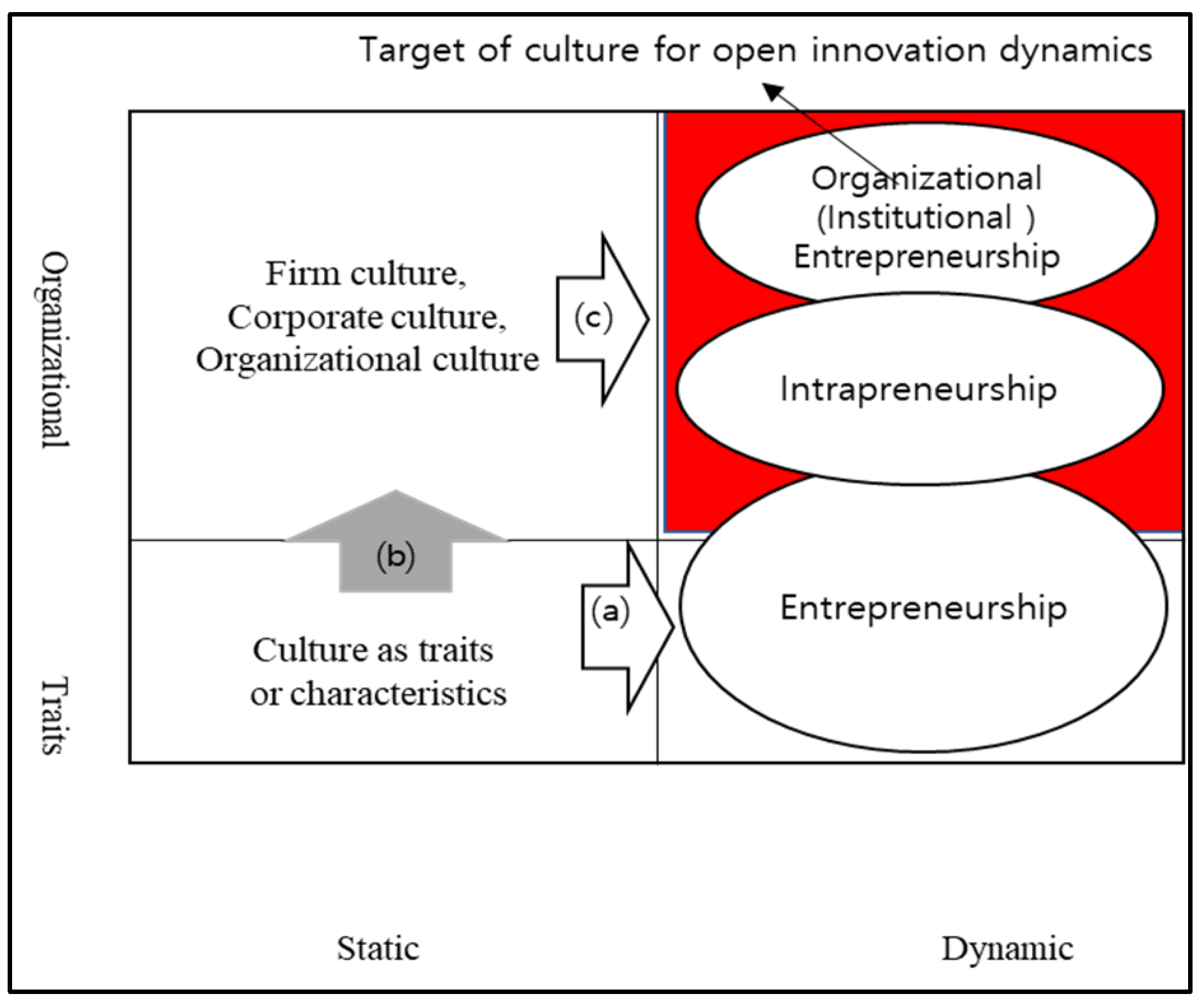
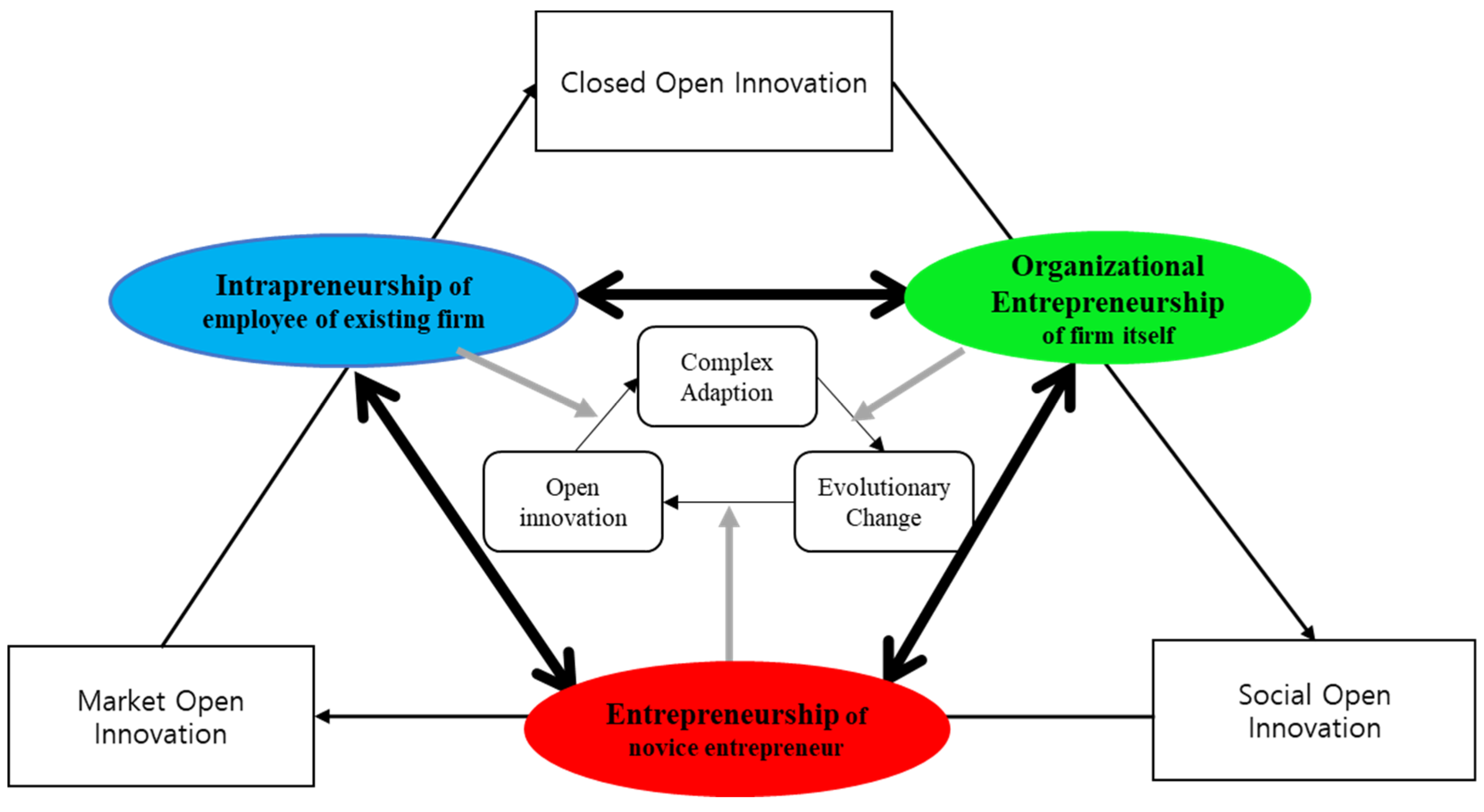
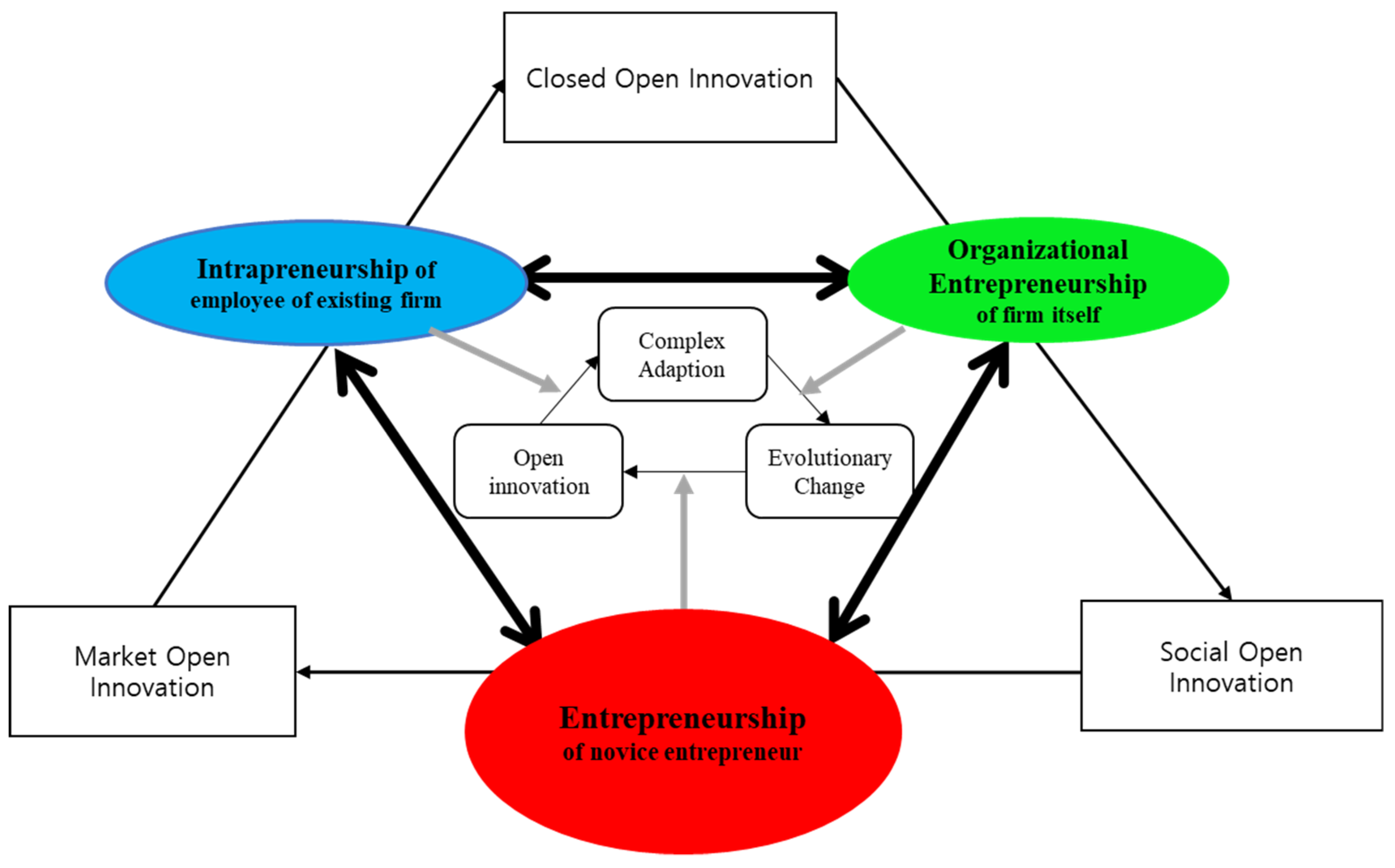
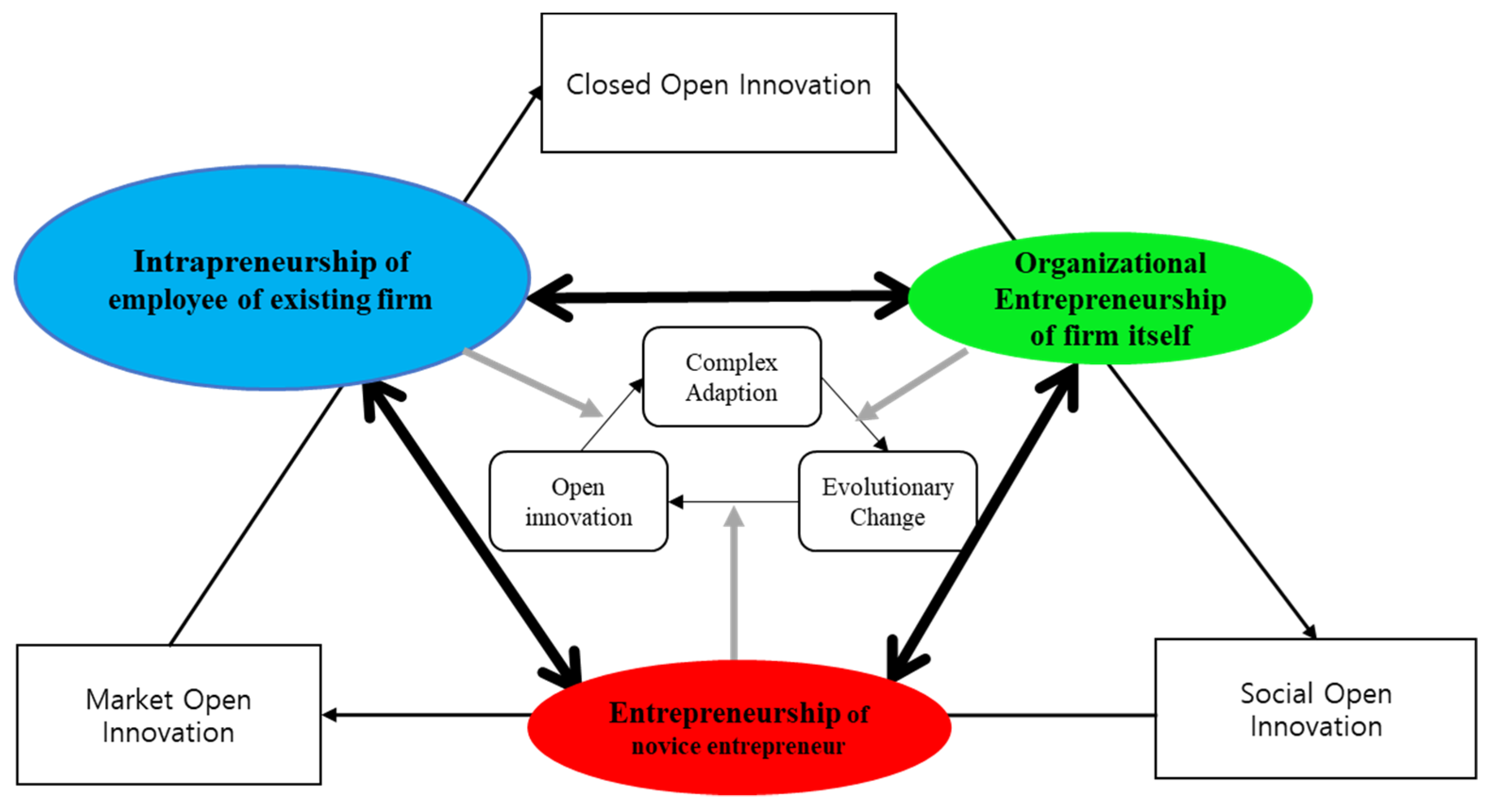
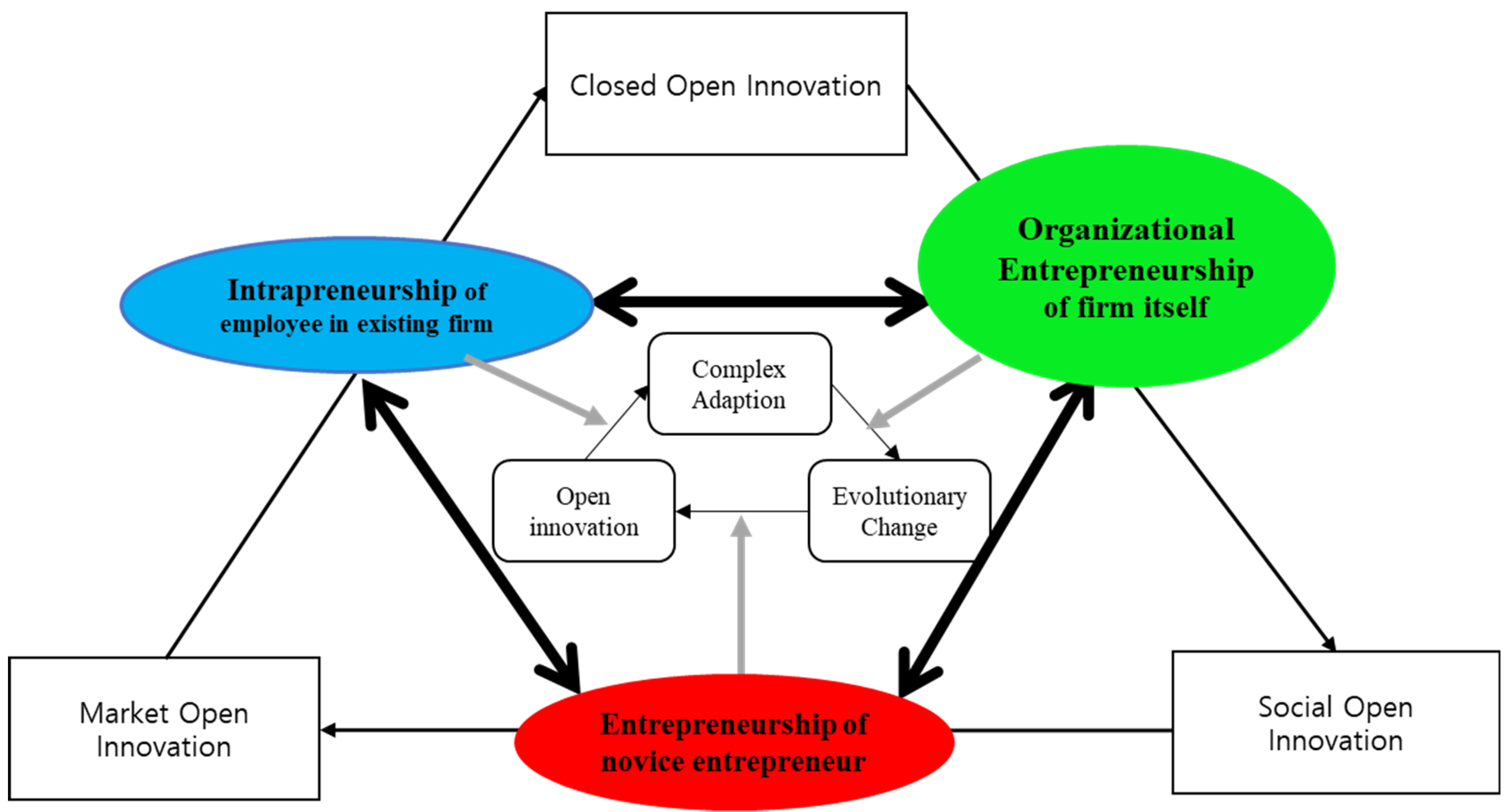
© 2020 by the authors. Licensee MDPI, Basel, Switzerland. This article is an open access article distributed under the terms and conditions of the Creative Commons Attribution (CC BY) license (http://creativecommons.org/licenses/by/4.0/).
Share and Cite
Yun, J.J.; Zhao, X.; Jung, K.; Yigitcanlar, T. The Culture for Open Innovation Dynamics. Sustainability 2020, 12, 5076. https://doi.org/10.3390/su12125076
Yun JJ, Zhao X, Jung K, Yigitcanlar T. The Culture for Open Innovation Dynamics. Sustainability. 2020; 12(12):5076. https://doi.org/10.3390/su12125076
Chicago/Turabian StyleYun, JinHyo Joseph, Xiaofei Zhao, KwangHo Jung, and Tan Yigitcanlar. 2020. "The Culture for Open Innovation Dynamics" Sustainability 12, no. 12: 5076. https://doi.org/10.3390/su12125076
APA StyleYun, J. J., Zhao, X., Jung, K., & Yigitcanlar, T. (2020). The Culture for Open Innovation Dynamics. Sustainability, 12(12), 5076. https://doi.org/10.3390/su12125076







